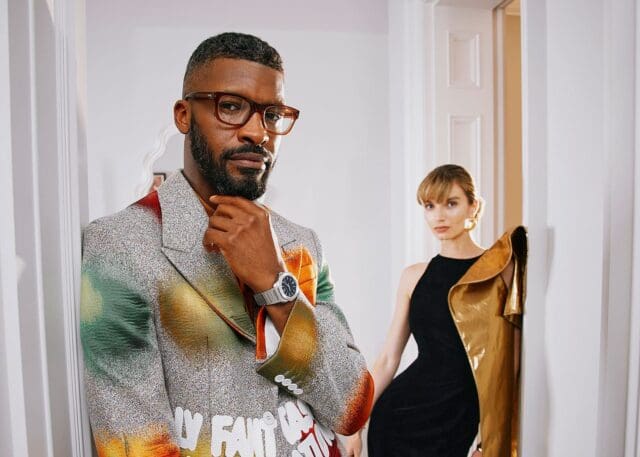
Philipp Humm: the Tech Investor Creating Tantalising Fine Art
Former CEO of Vodafone, T-Mobile and managing director of Amazon, Philipp Humm is now creating playful mise-en-scènes that examine the socio-politics of our contemporary digital world

‘Fail fast and fail often’ is a term that has gained traction thanks to its adoption by Silicon Valley as a tool to explain the extraordinary rate of innovation in the tech sector.
It is a concept that has gained so much in popularity that there is now an annual conference, FailCon, devoted to learning from the experience of failure. With an unparalleled degree of irony, FailCon itself was briefly halted due to being far more successful than its founders anticipated.
In its relationship to our feelings about freedom, failure has long been fertile territory for philosophers and psychologists. As we develop technologies that devolve more responsibility for making decisions to artificial intelligence, it is becoming increasingly vital to discuss our own role as instigator-overseer in the decision-making process. Or so believes Philipp Rudolf Humm, a German artist with a unique background as a philosopherturned-tech-leader-turned-artist.

Humm’s studio, in a quiet side street bordering Hampstead Heath, is a light, airy room on the first floor of an unassuming house, home to the artist and his partner, the photographer Danielle Mah. It is surprisingly modest for the former CEO of Vodafone, T-Mobile and managing director of Amazon, a tech investor who continues to sit on the boards of investment banks and global technology businesses, yet it is entirely appropriate for the philosopher-artist, a man working through some of the knottiest ethical topics of our age via his creative output.
A ground-floor gallery space houses recent paintings and sculptures, with large formatfigurative paintings in the bright, hard-edged style that one critic has called ‘Pop Expressionist’ lining the walls, with pride of place given to new sculptures in bronze. In the series of three sculptures, The Play (2017), each around two feet in length, an athletic woman whirls a smaller man through the air, sees him fall, and scoops him up. In another sculpture, Balance (2017), a calm, collected woman in contemporary dress stands face on to acharging horse with a dove falcon-like at her wrist, while a young girl urges the horse forwards, tugging on its dressage-plaited mane. The works, completed in London over the course of several months and cast in one of London’s only remaining artisanal foundries, summarise some of the key approaches taken by Humm toward articulating the challenges he sees.

Before studying art in London and Florence, Humm was a student at Germany’s Saarland University where he became interested in the existentialist philosophy of Martin Heidegger, whose idea of ‘thrownness’ (Geworfenheit in German) describes our existence as the result of accident and chance, the outcome of both our past and present. Heidegger’s idea was that this thrownness doesn’t dictate our future, but that it is part of our authentic selves, forming part of the concrete fact of our being (alongside things like our height, our age, etc.), which he called ‘facticity’ – the same consciousness that the French existentialist Jean-Paul Sartre later called ‘transcendence’.
The big idea, and the idea that informs much of Humm’s work, is that since our existence is a mix of concrete facts and thinking about what’s happened to us, and since no one can control our thinking, the freedom to think and therefore make choices, some terrible and destined to fail, is what defines existence. “It’s about the interplay between absolute power and belief, and the thrill of controlling – or believing that you can control – things that are inherently uncontrollable,” says Humm. He’s explaining a series of bronze sculpture showing tiny acrobats leaping over a charging bull (Minoan Bull Leaping (2017)). Using the language of classical sculpture and painting, taking references from the Old Masters and contemporary society, Humm’s work repeatedly questions our perception of freedom and dwells on the choices we make as a result of these freedoms, often showing symbolically the push and pull of the past and future.

The thrownness of the small man whirled by the athletic woman suggests the possibility of failure, her scooping up of him the possibility of recovery and redemption. Perhaps the young girl on the charging horse is the lure of the future, the carefully plaited mane the illusion that our being in the future can be controlled, the calm woman our authentic self. Yet these works can also refer to Humm’s view of our responsibility toward the advances of technology and our societal response to the changes that technology is engendering. “[The acrobats show] the way that modern scientists feel when they look at tech. They feel that they are skilled and can control it but if you make a little mistake…” A quick look at Wikipedia shows that mistakes haven’t been part of Humm’s business life, in a career that has progressed seemingly effortlessly from business school to management consultancy to C-suite roles. His successes in business gave his artistic career a startling beginning, with his first show covered on the front page of The Wall Street Journal, yet he struggled at first to reconcile the two parts of his life.
“At the beginning, I was pushing it away,” he says, now seeming extremely comfortable with the mix. “Now it’s moving together. At the beginning I didn’t want different worlds influencing each other, but after a while, I realised it’s about authenticity, and I needed to bring the two pieces together; they are all part of me and my art should reflect that.”

In his work, this drawing together of the two worlds has meant that he is more comfortable drawing on the skilled manipulation of meaning and iconography that he gained leading the marketing and advertising initiatives of the world’s biggest brands. A frequent figure in his painting work is Marengo, a large white horse who was Napoleon’s war charger, taken from an 1805 painting by Jacques Louis David of the Emperor crossing the Alps, and symbolising the eternal, repetitive tragedy of human overambition. Napoleon is an important figure to Humm. “Napoleon won it all and he lost it all. The tragedy is that he was able to conquer so much but not to see that he was going too far. His ambitions destroyed so many lands and people.”
Some writers have compared Humm to another businessman-turned-artist, Paul Gauguin. However, there are some essential differences. While Gauguin removed himself to a pre-industrial Tahitian idyll in a retreat from technological advance, Humm challenges the problems of technology head on. In Alienation (2017), a barefoot worker moves alone through the stages of creating luxury cars, accompanied only by her screen. The alienation and subservience of a robotics-dominated future and the unthinking choice-making that leads to a future where the choices are no longer ours is another execution of the themes of overconfidence and potential failure. “There’s so much discussion by super smart people around ethics and control, but for now everyone is thinking and no one is doing. It’s a reality we will have to find solutions for, because, like nuclear technology, there is no positive without a negative.”
Engaging with the potential of our choices to create technology that will fail us is perhaps an approach that only someone who has embraced a past filled with choices about technology creation can take. In bringing together the two parts of his life, Humm has provided the viewer with a privileged position from which to consider the issues that face us, in the process developing a fearlessness that seems set to take him far. Asked about the risks of pursuing an art career he chuckles. “In Germany, we have a saying, ‘Your last shirt is pocketless’. The cost is high, but you can’t take it with you.”

philipprudolfhumm.com









